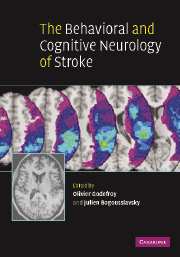Book contents
- Frontmatter
- Contents
- Contributors
- Preface
- 1 Evaluation of cognitive and behavioral disorders in the stroke unit
- Motor and gestural disorders
- Aphasia and arthric disorders
- 4 Aphasia in stroke
- 5 Acute vascular aphasia
- 6 Dysarthria
- 7 Alexia and agraphia in acute and chronic stroke
- 8 Acalculia and Gerstmann's syndrome
- Hemineglect, Anton–Babinski and right hemisphere syndromes
- Agnosia and Bálint's syndrome
- Executive and memory disorders
- Behavioral and mood disorders
- Dementia and anatomical left/right syndromes
- Index
- References
5 - Acute vascular aphasia
Published online by Cambridge University Press: 10 October 2009
- Frontmatter
- Contents
- Contributors
- Preface
- 1 Evaluation of cognitive and behavioral disorders in the stroke unit
- Motor and gestural disorders
- Aphasia and arthric disorders
- 4 Aphasia in stroke
- 5 Acute vascular aphasia
- 6 Dysarthria
- 7 Alexia and agraphia in acute and chronic stroke
- 8 Acalculia and Gerstmann's syndrome
- Hemineglect, Anton–Babinski and right hemisphere syndromes
- Agnosia and Bálint's syndrome
- Executive and memory disorders
- Behavioral and mood disorders
- Dementia and anatomical left/right syndromes
- Index
- References
Summary
Introduction
Aphasia has been studied extensively at the acute and subacute stages of stroke (see Chapter 4). However, these important studies do not adequately cover the initial stage (i.e. the first hours and days post-stroke), a critical period for the diagnosis and treatment of stroke. With the development of hyperacute management of stroke, a few studies have re-examined the characteristics, determinants, and prognosis of acute aphasia.
Aphasia at the acute stage of stroke
Aphasia is observed with a prevalence ranging from 21% to 33% of patients admitted for acute stroke (Brust et al., 1976; Laska et al., 2001; Godefroy et al., 2002). A very high prevalence (from 38% to 45%) has been observed at the hyperacute stage with tests including non-aphasic disturbances such as the language subtest of stroke scale (Pedersen et al., 1995) or a naming subtest (Riepe et al., 2004) and this presumably inflates the prevalence of aphasia (Thommessen et al., 2002).
Aphasic syndromes evolve rapidly during the first days post-stroke. Global aphasia is the most frequent syndrome observed with a frequency of about 25% (Laska et al., 2001; Godefroy et al., 2002); Wernicke's aphasia is also frequent (15–25%) followed by anomic aphasia, usually associated with various degrees of minor disorders of oral expression, transcortical motor aphasia, frequently associated with hypophonia in subcortical lesions (Kreisler et al., 2000), and Broca's aphasia (Brust et al., 1976; Laska et al., 2001; Godefroy et al., 2002).
- Type
- Chapter
- Information
- The Behavioral and Cognitive Neurology of Stroke , pp. 75 - 85Publisher: Cambridge University PressPrint publication year: 2007



